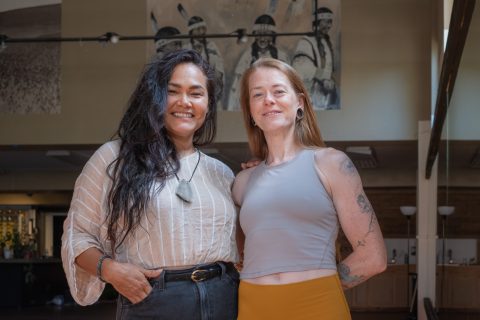Police officers of color feel ‘stuck in the middle’
Published 5:00 am Saturday, August 29, 2020

- Sandoval
HERMISTON — As the national discourse revolves around the relationship between people of color and law enforcement, belonging to both categories at once can be complicated.
“I’m feeling stuck in the middle,” said Hermiston Police Officer Erica Sandoval.
Trending
Sandoval, who is Latina, said she has mostly tried to stay out of the controversy as people have aired their feelings about both law enforcement and the Black Lives Matter movement. But some comments and social media posts from respected friends have hurt.
To Sandoval, policing is a calling, not just a job she picked on a whim and can leave just as easily. She may be able to take off her uniform at the end of her shift, she said, but in a small town she’s never really “off duty.”
“People still know who you are,” she said. “People still recognize you. They stop me in the grocery store.”
She and Victor Gutierrez, another Latino member of HPD, both said that race has played a role in interactions they have had throughout their career.
Gutierrez, currently a detective, started out in Boardman as the only Spanish-speaking officer there. Sometimes, he said, white people would direct all their comments to the newer white officer he was training, even after they were told he was in charge of the investigation.
Now that he works as a detective in plain clothes, he pointed to a recent experience where someone he talked to during the course of an investigation didn’t believe he was a legitimate detective, even after he showed his badge and business cards.
Trending
Officers of color sometimes experience racism against them from people who don’t think they’re “worthy” of their badge because of their race, Gutierrez said. He has also gotten criticisms from Latinos about his choice of profession, and has been accused of racism.
“Hispanics didn’t really approve of me enforcing the law,” he said while describing his time as an officer in Boardman. “They felt I was being racist toward them because I did not cut them a break.”
Sandoval said she lost friends when she chose to enter law enforcement, but she feels her job puts her in a position to help people. Victims often feel more comfortable talking to someone who looks like them.
“I’m so grateful my parents made me learn Spanish,” she said. “When I show up and talk to people in Spanish, you can just see that look of relief and hope.”
Sandoval, who used to be the only female sworn officer on the force, said it is also reaffirming when female sexual assault or domestic violence victims disclose details to her that they weren’t comfortable sharing with a male officer.
Seven of Hermiston Police Department’s 28 sworn officers are bilingual, according to Police Chief Jason Edmiston, although he said that was a number the department could still “definitely do better with.” Two out of the department’s three school resource officers are bilingual people of color, and two officers became U.S. citizens to get their jobs. Sandoval is also no longer the only female officer on the force.
Edmiston said having a diverse police force strengthens the department, and fulfills the resolution the city of Hermiston adopted in 2006, making a commitment to actively work to be an “inclusive community.”
“We have to be representative of the community we’re policing,” he said.
While Sandoval and Gutierrez spoke about their experiences with how members of the community treat them, much of the conversation around police reform nationally has been about how members of law enforcement and the justice system treat people of color.
Black Americans make up about 13% of the population, but about 27% of arrests, according to FBI reporting, and they are also about twice as likely to be shot and killed by a police officer. Protesters under the Black Lives Matter banner have protested against such deaths, and against what they describe as systemic racism that runs much deeper than the actions of a few “bad apples.”
Hermiston Police Department has had its own critics, including Black Lives Matter protesters in Hermiston who were met with armed counter-protesters on Aug. 21. Some on the BLM side were vocal that night and on social media afterward about their feelings the department was giving preferential treatment to white counter-protesters over people of color those counter-protesters were coming across the street to confront.
Sandoval defended the officers of the Hermiston Police Department, saying she has been “surrounded by really great guys” during her career there. She said officers at the department got into policing because they wanted to help people, and that people who choose a law enforcement career for other reasons usually don’t last long in the profession.
As for videos of police brutality in other cities, Gutierrez said he couldn’t speak to the motivations of departments in other cities where he has not worked.
“I can’t control what’s happening outside the area,” he said. “I do pay attention to the news, but I look at, ‘What can I do to fix it?’ If I see (misconduct), I will definitely speak my mind to my supervisor or the chief.”
Both Sandoval and Gutierrez said they were strong proponents of transparency measures, such as body cameras, and disagreed with departments that have resisted adopting them. Sandoval said since HPD adopted the cameras in 2015 they have been a “blessing on all sides” by holding officers and citizens alike accountable for their behavior during interactions.
“We’re not trying to hide anything,” she said.
Edmiston said he was glad the union was “absolutely in favor” of body cameras when he first broached the subject with them. Officers make hundreds of decisions a day and aren’t perfect, he said. When citizens make complaints, it is helpful to be able to review body camera footage to see if an officer fell short, and provide correction as needed.
“When we don’t put our best foot forward we need to take appropriate action,” he said.
With the spotlight shining bright on police actions right now, Sandoval said she still believes she is where she is supposed to be. She hopes she can be a voice for good through all of this as both a police officer and a person of color.
“Above all else, we’re human,” she said. “We’re fathers and sisters and mothers and brothers and aunts. I know that sounds cliche, but that’s where we’re coming from.”









